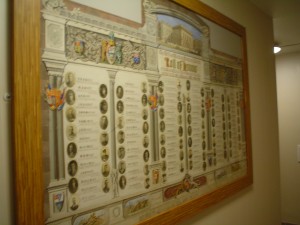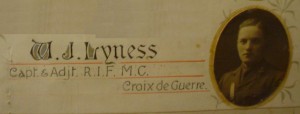Moira Hero Captain William James Lyness MC** was one of only 168 men in the British Army to receive three Military Crosses in the First World War.
 Around 200 bank officials from the Northern Banking Company and the Belfast Banking Company served in the Great War. 15% of them died during the conflict.
Around 200 bank officials from the Northern Banking Company and the Belfast Banking Company served in the Great War. 15% of them died during the conflict.
Amongst those bank officials who volunteered and served was Tullyard man, Captain William James Lyness. He was the son of William John Lyness and Frances Mary Lyness from Tullyard, Moira, Co. Down.
Lyness worked in the College Green, Dublin branch of the Belfast Banking Company prior to his enlistment as a cadet in Colonel Shannon-Crawford’s battalion. He then went on to serve with the Royal Irish Fusiliers and attained the rank of Temporary Lieutenant (1916), Captain and Adjutant (1918).
He saw action at Messines, Langemark, Cambrai and the Somme (1918). During his military career Lyness was awarded 3 Military Crosses and the Croix de Guerre. Only 168 men received 3 Military Crosses during World War One, a testament to how brave Captain Lyness was.
“For conspicuous gallantry and devotion to duty when clearing a wood with his platoon. In spite of the very strong resistance which he met, his dispositions and leadership were excellent, and after heavy fighting at various points he captured a large number of prisoners and guns of various calibre. His splendid gallantry and coolness proved invaluable as an example to his men.”
The London Gazette of 17th September 1917
“For conspicuous gallantry and devotion to duty. When visiting his outpost line he was fired on by the enemy at forty yards range, whereupon he obtained a Lewis gun, stood up in full view of the enemy and fired it from his shoulder until it jammed. He then rushed the enemy post with two bombers, and cleared them out. He had already led a successful attack on the two preceding nights, and it was entirely due to his initiative and personal courage, in spite of three days without sleep, that his posts were established and our position made secure.”
The London Gazette of 18th October 1917
“When the right flank of the brigade war held up he went forward to reconnoitre and unexpectedly met with a nest of machine guns and about fifty of the enemy, who opened very heavy fire. With great difficulty he made his way back, got a Lewis gun and a man with a supply of magazines and went forward again, engaged the strong point, firing eleven magazines, killing the majority of the enemy, and capturing a machine gun. He then led the flank forward about 500 yards and straightened out the line. The man with him was killed and he was wounded. He showed great gallantry and determination.”
The London Gazette of 10th January 1919
“Captain and Adjutant W. J. Lyness, M.C. Royal Irish Rifles, wounded, is a son of Mr. W. J. Lyness, Tullyard House, Moira, and nephew of Mr. R. Logan, Belfast Bank, Bangor. Before the war Captain Lyness was on the Belfast Bank’s Dublin staff. He was a cadet in Colonel Shannon-Crawford’s battalion prior to receiving his commission. Captain Lyness, who has been adjutant of his battalion since 22nd March, has a fine record of service, having won both the Military Cross and a bar thereto. His brother, Lieut. I. Lyness, of the Tank Corps, also holds the Military Cross. Captain Lyness has been wounded in the shoulder by a bullet, but his injury is not serious.”
Lisburn Standard of 13th September 1918
 The Lyness family still reside at Tullyard, Moira.
The Lyness family still reside at Tullyard, Moira.
Military Cross Statistics – The Great War – 37,104 singles, 2,984 with 1st bar, 168 with 2nd bar, 4 with 3rd bar
In December 1914 the Military Cross was instituted to recognise “distinguished services in times of war of Officers of certain ranks in Our Army”. The majority of Military Crosses were awarded for gallantry, but the decoration could also be granted for “distinguished and meritorious service”.
The French Croix de Guerre was either awarded as an individual or unit award to those soldiers who distinguished themselves by acts of heroism involving combat with the enemy.
For further information on Banking memorials visit
http://northernbankwarmemorials.blogspot.co.uk/
http://ulsterbankwarmemorials.blogspot.co.uk/
Research by Gavin Bamford, a member of History Hub Ulster https://historyhubulster.co.uk
